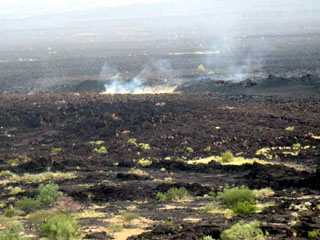Report on Manda Hararo (Ethiopia) — 1 July-7 July 2009
Smithsonian Institution / US Geological Survey
Weekly Volcanic Activity Report, 1 July-7 July 2009
Managing Editor: Sally Sennert.
Please cite this report as:
Global Volcanism Program, 2009. Report on Manda Hararo (Ethiopia) (Sennert, S, ed.). Weekly Volcanic Activity Report, 1 July-7 July 2009. Smithsonian Institution and US Geological Survey.
Manda Hararo
Ethiopia
12.17°N, 40.82°E; summit elev. 600 m
All times are local (unless otherwise noted)
A large sulfur dioxide plume and several thermal anomalies from Manda Hararo were detected in satellite imagery during 28-30 June. Thermal anomalies detected in satellite imagery indicated a surface lava flow in the Karbahi region. Karbahi is a graben area with numerous active faults, fissures, and basalt flows, NW of the center of the broad Manda Hararo volcanic complex. Preliminary data suggested that the eruption was larger than the previous eruption in August 2007. On 8 July, a scientist that visited the area reported fresh lava flows, an eruptive fissure that was about 5 km long, and gas emitting from multiple cones.
Geological Summary. As the southernmost axial range of western Afar, the Manda Hararo complex is located in the Kalo plain, SSE of Dabbahu volcano. The massive 105-km-long and 20-30 km wide complex represents an uplifted segment of a mid-ocean ridge spreading center. A small basaltic shield volcano is located at the N end of the complex, S of which is an area of abundant fissure-fed lava flows. Two basaltic shield volcanoes, the larger of which is Unda Hararo, occupy the center of the complex. The dominant Gumatmali-Gablaytu fissure system lies to the S. Voluminous fluid lava flows issued from these NNW-trending fissures, and solidified lava lakes occupy two large craters. The small Gablaytu shield volcano forms the SE-most end of the complex. Lava flows from Gablaytu and from Manda overlie 8,000-year-old sediments. Hot springs and fumaroles occur around Daorre lake. The first historical eruptions produced fissure-fed lava flows in 2007 and 2009.
Sources: Hawai'i Institute of Geophysics and Planetology (HIGP) Thermal Alerts Team, The Guardian News, Simon Carn

